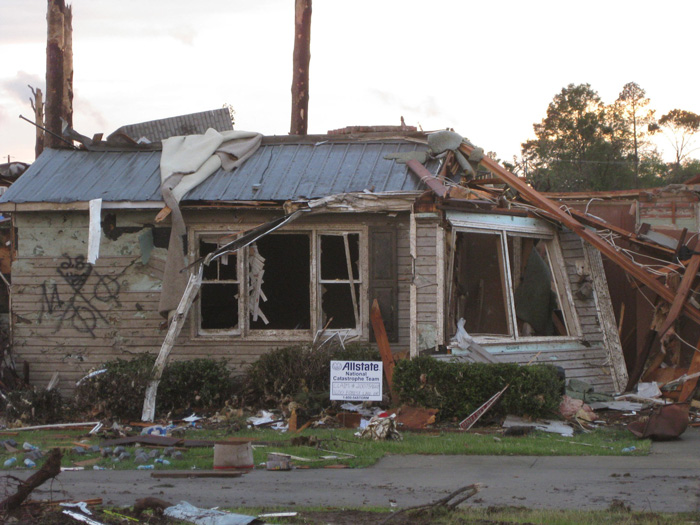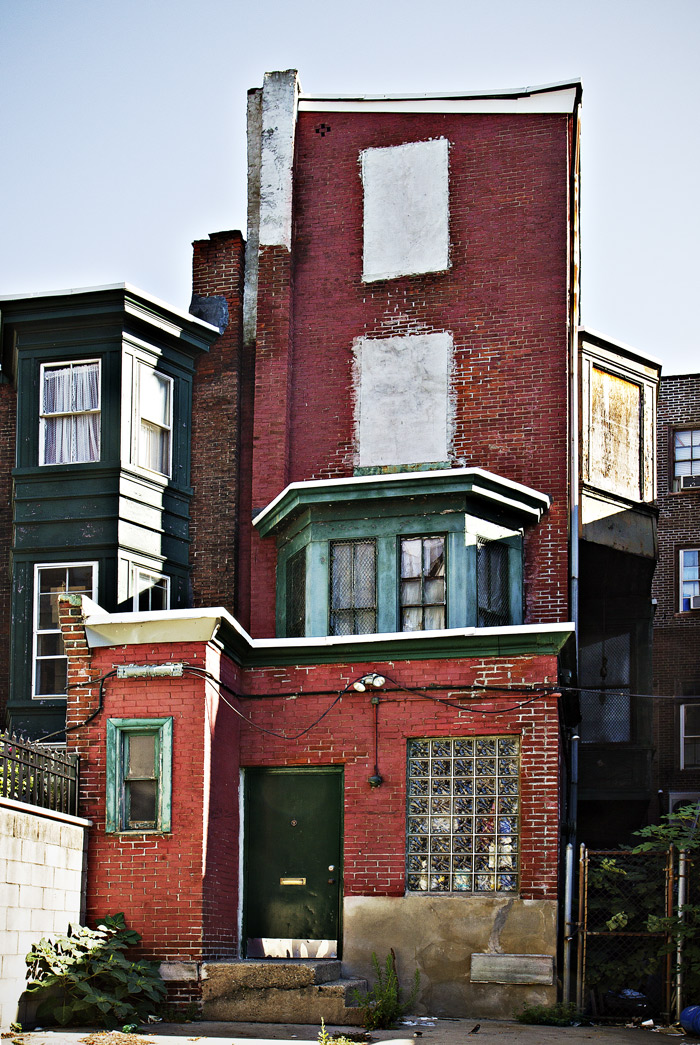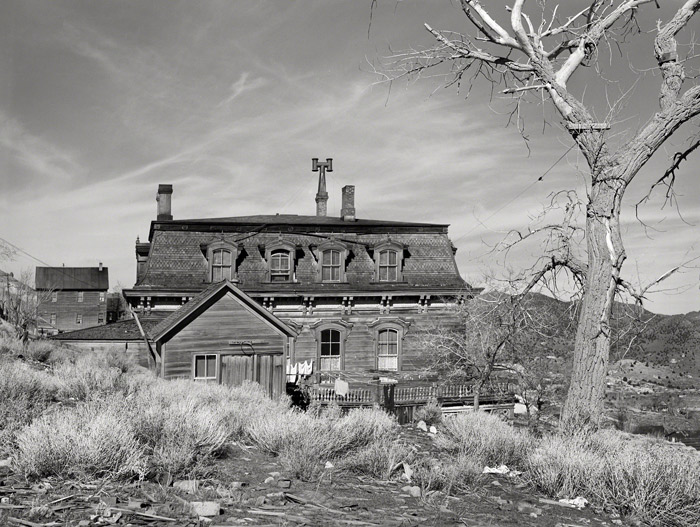Hole in the Clouds
Oct 22, 2009

Ninety-eight winters of salt have done a number on the mortar that was supposed to be holding the bricks together on my front steps. Fortunately, I count among my good friends an experienced bricklayer who was willing to take on the project. Here you see Katrin Maldre chipping away at the old mortar, using my little old rock hammer and a fancy new chisel.
To be fair, Katrin's bricklaying experience was not extensive or recent. But one summer back in Communist times, when she was growing up in Estonia, she and her friends were sent out into the country to work on a large brick construction project. Mostly, they moved bricks to and from piles---but it's a whole lot more bricklaying experience than I can claim.. (Katrin also has a son who has an engineering degree and knows about bricks and stuff, and who was willing to supervise this project from Estonia via Skype.)
Within an hour or two we got rid of most of the old mortar, slathered the free bricks with new mortar, and set them back in place. We broke one brick, and when the job was finished we somehow had an extra piece of brick left over. But you can't tell by looking at it.
The highlight of the job was definitely the new chisel. Note that yellow foam hand protector thing. Worth its weight in gold! Its inventor is a genius.
Portland
Maine
Katrin Maldre
house
bricks
tools
(Image credit: Ellen Stein)
Jun 25, 2010


The ninth annual Solar Decathlon International is under way in Madrid; teams from seventeen universities in Europe, Asia, and the Americas have built solar-powered houses for the competition.
Almost all the entries are box-shaped houses topped by complicated solar panels. This one is different; can you guess where it's from? The Institute of Advanced Architecture in Barcelona, where it was designed for a climate in which cooling as opposed to heating is a major challenge.
"The twentieth century was the architectural age of form follows function," notes the statement accompanying this entry. "The twenty-first century is the age of form follows energy."
The winning house will be named next week. I'll try to keep you posed.
Spain
Barcelona
house
Institute of Advanced Architecture
solar energy
May 12, 2011
 The April 27 tornado that stayed on the ground for more than eighty miles through Tuscaloosa and Birmingham, Alabama, has now been classified F4, not F5, as I mistakenly indicated in a posting here on May 1. There were three definite F5 tornadoes that same day, including one in north Alabama that completely obliterated the town of Hackleburg.
The April 27 tornado that stayed on the ground for more than eighty miles through Tuscaloosa and Birmingham, Alabama, has now been classified F4, not F5, as I mistakenly indicated in a posting here on May 1. There were three definite F5 tornadoes that same day, including one in north Alabama that completely obliterated the town of Hackleburg.
But F4 is plenty bad enough. Forty-one people died in Tuscaloosa.
This is what's left of our old house. It was a two-story house, but the second story was set back a bit, and it's completely gone. At the extreme right of the picture is the doorframe for the front door, which is gone. At left is a spray-painted "Katrina cross" indicating that the rubble was searched on April 28 by search team "M," and no people or pets were found.
Tuscaloosa
Alabama
house
ruins
tornado
(Image credit: Ben Shankman)
Mar 26, 2012
 Yellow House by Judith Schermer.
Yellow House by Judith Schermer.
painting
art
house
Philadelphia
(Image credit: Judith Schermer)
Nov 29, 2012
 The landlord told the tenants in this little house in Seattle that the place needed painting, and that he and his guys would be taking care of it. And it was true, apparently, that it needed painting, and also true that the landlord and his guys came over recently to do the work.
The landlord told the tenants in this little house in Seattle that the place needed painting, and that he and his guys would be taking care of it. And it was true, apparently, that it needed painting, and also true that the landlord and his guys came over recently to do the work.
The job took two weeks. They painted a sunrise on this side of the house, and a sunset on the other side. Before then, both sides had been plain and gray.
The tenants say they like the house and they like the landlord, and it will take a lot more than this to get them to leave.
Washington
house
mural
Seattle
paint
(Image credit: John Stein)
Jul 17, 2013
 House on Cypress Street near Broad in downtown Philly.
House on Cypress Street near Broad in downtown Philly.
house
streetscape
Philadelphia
Oct 5, 2013
 There's a new mural in the neighborhood, bolted high on the wall of a new house at the corner of Fitzwater and Smedley. Looks to be a private project, not part of the city's Mural Arts Program, and it's hard to say if it's intended as permanent street art, since it mostly blocks the windows of the house. But it's something to look at, a portrait of Nelson Mandela looming above a scrim of drippy red and black streaks. The painter signed the mural illegibly; we believe that whoever he or she is, he or she got it right, those dark, worldly, heavy-lidded eyes in a brilliant red face.
There's a new mural in the neighborhood, bolted high on the wall of a new house at the corner of Fitzwater and Smedley. Looks to be a private project, not part of the city's Mural Arts Program, and it's hard to say if it's intended as permanent street art, since it mostly blocks the windows of the house. But it's something to look at, a portrait of Nelson Mandela looming above a scrim of drippy red and black streaks. The painter signed the mural illegibly; we believe that whoever he or she is, he or she got it right, those dark, worldly, heavy-lidded eyes in a brilliant red face.
art
house
streetscape
mural
neighborhood
Nelson Mandela
Nov 23, 2013
 They're gutting yet another house in the neighborhood.
They're gutting yet another house in the neighborhood.
house
streetscape
window
work
neighborhood
Philly
(Image credit: Little Fuji)
Jun 2, 2014
 Every day in Philadelphia, houses are declared dead, mostly after long years of painful dilapidation and decay. If they don't collapse or crumble of their own weight, they are demolished, eventually, without ceremony; the machines show up, and the trucks haul away the pieces.
Every day in Philadelphia, houses are declared dead, mostly after long years of painful dilapidation and decay. If they don't collapse or crumble of their own weight, they are demolished, eventually, without ceremony; the machines show up, and the trucks haul away the pieces.
Until Saturday, 3711 Melon Street in West Philly's Mantua neighborhood was no different from all the others. It had sheltered families since 1872. The last owner was Leona Richardson, who bought it in 1946 and brought up her son Roger there. Mantua was a good place to raise a family; the neighbors were poor, but they looked after one another, and they had stores, schools, churches, a post office, a movie theater, a firehouse. The houses were small and already old, rotting, cracking, always needing some kind of repair, but a single mother like Leona Richardson could afford to buy a home of her own in Mantua, and could live there comfortably and see her son grow up and get an education.
Eventually, Miss Leona paid off the house on Melon Street and bought another place a few blocks away, where she lived until her death in 2002. Even before she died, the old house was becoming harder and harder to keep up; after she died, it was basically abandoned. Today, shells of houses like 3711 Melon Street are offered for sale in the neighborhood for $30,000; they languish on the market; nobody thinks they're worth that much. They're 140 years old now, and in recent years they've been better homes for rats than for people.
People have tried to find shelter in them, of course. Drunks and addicts have used them when they could. Drug wars have been fought in and around them. Neighborhood children died in some of these empty houses.
The neighborhood as a whole was grievously wounded, losing families and homes and businesses and city services, and when finally the worst of the houses were sold for scrap, ripped apart and hauled away, the wounds in the fabric of the neighborhood became scars, marks of permanent disfiguring damage. Now only weeds grow tall where once families had flourished. There are more and more gaps in the blocks of rowhouses, ugly gaps, like missing teeth.
But the passing of 3711 Melon Street last Saturday did not go quietly. A proper funeral was observed, complete with flowers, organ, remembrances, eulogy, black armbands, folding fans, food, and "Leaning on the Everlasting Arms." There were printed programs, with color photos of the deceased. And when the machine tore into the house, pallbearers were at the ready, accompanying the dumpster load of what was once a home to its place of final repose.
Needless to say, the funeral for 3711 Melon Street was observed in such a public manner because politicians and community organizers were wanting to draw attention to some of their work. The ground on which the lost house had stood will become part of a parcel slated for development as affordable housing. "Plan, or be planned for," several of the speakers told the gathering.
"I've learned that you can tell a lot about a person," one of the speakers noted, quoting the very recently departed Maya Angelou, "by the way she handles these three things: a rainy day, lost luggage, tangled Christmas tree lights."
The neighbors of Mantua have had to handle a hell of a lot more than those three things. Our thoughts are with them as they deal with this fresh loss.



house
streetscape
Philadelphia
neighborhood
West Philly
Mantua
funeral
3711 Melon St
Mt. Olive Baptist Church
(Image credit: Little Fuji)
Mar 7, 2016

In 1930, when Allen Frederick Larsen of Muscatine, Iowa, was four years old, he sat for his portrait up on the rooftop, his bare feet dangling over the overhang. His own father took this photo, we're told, along with many others showing young Allen in precarious poses–often on rooftops, sometimes on railroad bridges. "It's a wonder he grew up to meet Mom," notes his daughter. "Grandfather took a lot of pictures."
house
portrait
1930
child
roofscape
Allen Frederick Larsen
(Image credit:Larsen via Shorpy)
Apr 17, 2016
 With this picture we begin a very occasional series exploring the latter-day habitats of the five Stein boys, who all long ago sheltered under one roof in Tuscaloosa, Alabama, but who have now scattered to the far corners of the realm.
With this picture we begin a very occasional series exploring the latter-day habitats of the five Stein boys, who all long ago sheltered under one roof in Tuscaloosa, Alabama, but who have now scattered to the far corners of the realm.
Ted has built himself a homeplace high on a hill above Great Cacapon, West Virginia. About a year ago, a friend from Alabama, Tommy Roberts, drove up to Ted's land hauling his tools and a trailer full of old shipping pallets. Pieces of pallets eventually became siding shingles to sheath the house and outbuildings–but first, Tommy and Ted had to build the house, drill the well, install the woodstove for heat and the gas stove for cooking, run electricity in from the pole by the road, and etc. and etc.
The stone wall and outdoor fireplace were built with rocks from around Ted's land; the presence of all the loose rocks was a good sign, according to the neighbors, proving that his property included a goodly amount of flat land for loose rocks to settle on. Ted recently expanded his place by buying more acreage across the road, so he's now got a little guesthouse, and of course if he happens to ever need even more rocks . . . .
Ted builds software for a living, and the wireless in the woods above Great Cacapon is slow. Even so, it's fast enough for government work, as the saying goes, and lately, most of Ted's work has been government work. He can write code in Tedland or discuss work with colleagues or clients, in the house or on the deck or in a hammock under the trees. But every now and then he has to leave his mountainside and drive to Washington to make sure all is well with NASA or the State Department or USGS or whomever; for such occasions, he has rented a room in town.
When he's off the mountain, he probably has to make arrangements for somebody to look after his chickens.
house
West Virginia
woods
stone
Great Cacapon
Cacapon River
wheelbarrow
(Image credit: Ted Stein)
Jan 30, 2018
 There's laundry in the yard here at the old Savage house, but only a few items; most of the clotheslines hold only empty clothespins. So we'll call it a Tuesday instead of a Monday.
There's laundry in the yard here at the old Savage house, but only a few items; most of the clotheslines hold only empty clothespins. So we'll call it a Tuesday instead of a Monday.
The house was built in 1861, only two years after discovery of the Comstock Lode, which set off a silver rush to Nevada, much like the gold rush to California a decade earlier. Administrative offices of the Savage Mining Company occupied the first floor; a succession of mine superintendents and their families lived above the offices, on the second and third floors.
The office and house were on D Street in the very young town of Virginia City, Nevada. The first Savage mine shaft was on B Street. Although the town was barely a year old in 1861, it already contained 42 saloons, 42 stores, 9 restaurants, 6 hotels, and a couple of thousand miners, many of whom had already spent years prospecting in California.
All the trees for miles around were already cut down, mostly for use as mine timbers.
The Savage mansion had 21 rooms and was probably the largest structure in town. The company provided a housekeeper for the superintendents in residence, and for many years the housekeepr was a Mrs. Monoghan, whose husband had died in one of the Savage mines.
In 1918, when Savage shut down its operations in Virginia City, after years in which mines thereabouts produced less and less good ore, the house, furnishings, and D Street property were deeded to Mrs. Monaghan. By the time this photographer happened by in 1940, the silver bonanza that built the house and the city had been over for a long, long time.
Recently, Virginia City is gentrifying, attracting tourists. The Savage Mansion is now completely restored and painted yellow. The building is still privately owned and serves as office space.
vintage
house
mining
work
1940
decay
Leonard Coates Savage
Comstock Lode
Virginia City, Nevada
(Image credit: Arthur Rothstein via Shorpy)















